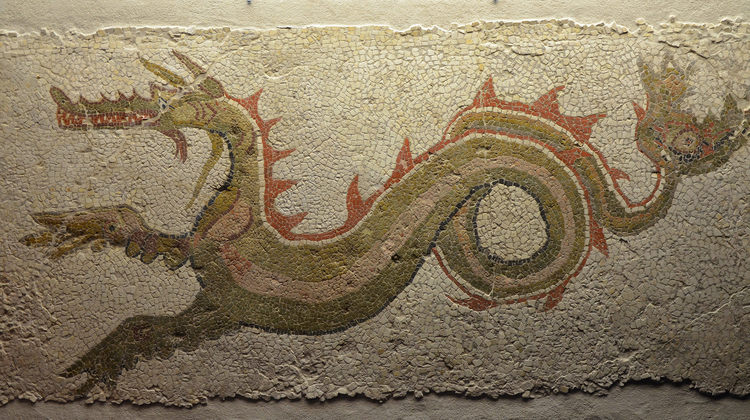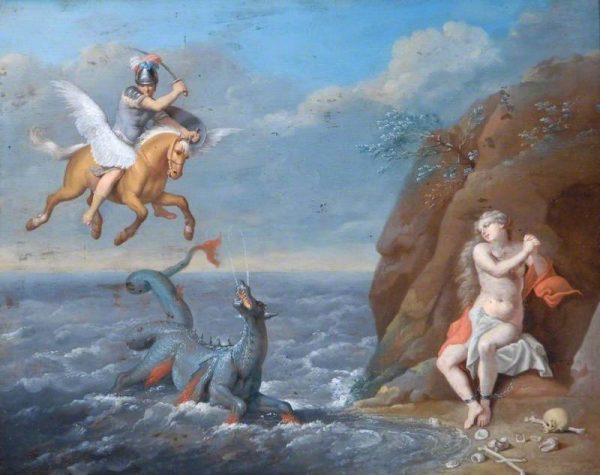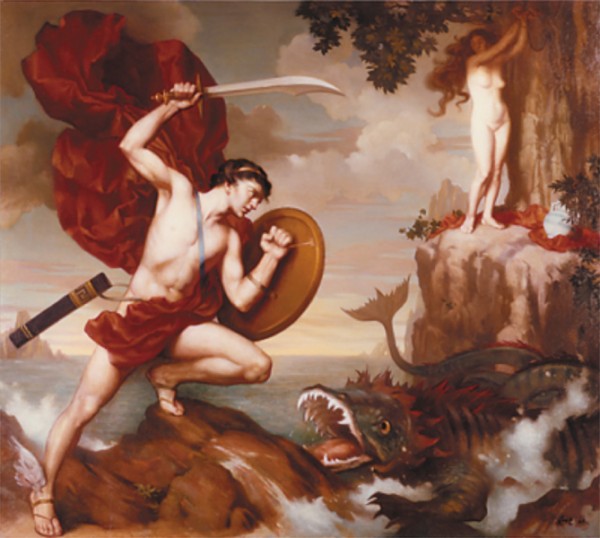Written by Katherine Smyth, Contributing Writer, Classical Wisdom
The story of Perseus and Andromeda is well known from the hero’s side, but who really was the woman he saved? No one seems to know. For eons scholars and bards alike have argued and debated. Artists have studied her, represented her in statues, music, and paintings. Yet, the question remains: who is this mysterious woman of the Mediterranean?
Beautiful beginnings
We’ll begin Andromeda’s story with what we know. She is a princess—the daughter of King Cepheus of Aethiopia, and his queen, Cassiopeia—and has been promised to Cepheus’ brother, Phineus, as a bride.
Andromeda is beautiful, and her mother makes sure everyone knows just how beautiful her daughter is. It’s this hubris, or utter foolishness, that angers the immortals. Cassiopeia’s boasting goes so far as comparing her daughter’s beauty to be far greater than that of the Nereids, the nymph-daughters of Nereus, who accompany Poseidon.
Once insulted, Poseidon sets out to punish Cassiopeia for her arrogance, and as part of this punishment, he sends the monster Cetus (κῆτος), to ruin the kingdom’s coastline. So, Cetus produced a ravishing storm, tearing apart ships and villages, and as the waters rose the area became flooded.

Mosaic with a ketos (sea monster – Latinized as Cetus) found at Caulonia (Monasterace) in the Casa del Drago, 3rd century BCE. [Source: Ancient.eu]
Enter the hero
While waiting, in the midst of a maelstrom, the hero Perseus spots Andromeda from the back of a winged-Pegasus. Having spotted the damsel in distress, he swoops in.
As Perseus’ feet touch the sodden rock, his eyes fall upon beautiful Andromeda, and both of their fates are sealed. As the monstrous Cetus approaches, Perseus retrieves the Gorgon Medusa’s head from its magical sack, and the foul beast is instantly turned to stone. He then frees Andromeda and they return to the palace to be wed.
Unfortunately, things don’t go smoothly for the young couple. Perseus marries Andromeda in spite of her being betrothed to her uncle Phineus. The jilted groom becomes enraged and plots to kill Perseus with help from some allies.
During the wedding, a brawl breaks out when Phineus attempts to spear Perseus. Perseus is eventually surrounded by his assailants and is forced to use Medusa’s head once more. Phineus and his allies are all turned to stone and, although a lawful defense, the couple choose to leave Aethiopia soon thereafter.
Married life and beyond
Andromeda follows her husband to Serifos, where he saves his mother Danaë, and then on to Tiryns in Argos, where they become King and Queen. Andromeda bears many children, and the couple reign peacefully and competently over Tiryns.
Through their union, the family of the Perseidae are born, via their son Perses. Along with Perses, they have six other sons together: Alcaeus, Heleus, Mestor, Sthenelus, Electryon, and Cynurus, along with two daughters, Autochthe and Gorgophone.
It is their descendants who would rule Mycenae for several generations, and who would eventually produce several well-known heroes, such as Heracles. According to Greek mythology, Perses is also the ancestor of the Persians.
How does Andromeda’s story end? Well, after she died, the goddess Athena transformed her into a constellation in the northern sky, as a reward for her courage, duty, and virtue. Andromeda is nestled near both her husband Perseus and her mother Cassiopeia.
Andromeda today
Since the 2nd-century, when Ptolemy listed Andromeda’s constellation, among 48 others, we’ve been gazing at her starry tale. It has remained to this day one of the 88 officially recognized constellations, and can be seen along with four other nearby constellations that are closely associated; Cephus, Cassiopeia, Pegasus, and Cetus.
Star-gazing isn’t the only way you can be inspired by Andromeda’s story, she’s been featured in the plays of Sophocles and Euripides, and in more modern times by the French tragedian Corneille and the French-Italian composer Jean-Baptiste Lully.
Andromeda is the subject of many well-known artworks, painted by artists such as Titian, Wtewael, Veronese, Ingres, Moreau, and Rubens. From the Renaissance forward, Andromeda began to appear nude and usually chained while waiting for Cetus to devour her. Cesari’s Perseus saving Andromeda is an example of this style, however, Rembrandt’s Andromeda Chained to the Rocks shows a fearful and partially clothed Andromeda.

Wide angle view of the Andromeda Constellation, with the Andromeda Galaxy visible as a hazy oval. [Photo copywright: 2012 by Fred Espenak]
Whatever the exact origins of the mythology surrounding her, Andromeda stands out as an important figure, from the days of the ancient Greeks to our own. Her story is an inspiring one, escaping certain death and going on to become a reputable Queen.
While it is difficult for us moderns to be as awe inspired by these tales as the ancient Greeks were, perhaps we can get a taste of that when we look up at the night sky and see the majesty that is the constellation of Andromeda.












No comments
Trackbacks
Our apologies, you must be logged in to post a comment.